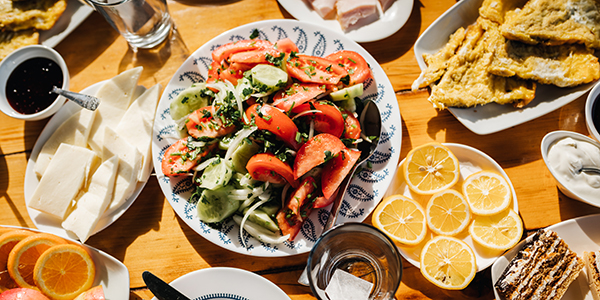Discover the Mediterranean Eating Plan
The Mediterranean diet is a heart-healthy eating plan based on traditional foods of the countries bordering the Mediterranean Sea. Following this diet can help reduce your risk of heart disease and support healthy aging. It's no surprise so many people are changing their eating habits to include these delicious foods.
How It Works

- Eat mostly plant-based foods. Enjoy plenty of vegetables and fruits. Choose a rainbow of colors. Legumes such as beans, lentils, nuts, and seeds are a main source of protein.
- Go fresh. Eat fresh, local and in-season foods. When choosing frozen or canned foods, stay away from added sauces, sodium (salt) or sugar. Eat fewer processed foods.
- Choose whole grains. Not all grains are the same. At least half the servings of grains you eat each day should be whole grains. Enjoy whole-wheat pasta and bread, plus brown rice, barley, oatmeal, shredded wheat cereal or popcorn. Eat fewer refined grains, such as white rice and items made from white wheat (pastries, pasta or bread).
- Eat more fish. Eat fish more often than meat and poultry. Try oily fish like salmon, sardines or tuna.
- Choose healthy oils. Cook with healthy oils like olive, canola or avocado instead of butter. Limit foods high in saturated fat like fatty meats and full-fat dairy products. Avoid trans-fats, such as hydrogenated oils, as much as possible.
- Sip red wine in moderation. If you like, have a glass of red wine with meals. Men under 65, limit your intake to two glasses a day. One glass per day is the recommended limit for women and anyone over age 65. A serving size is 5 ounces.
- Rethink your plate. To help you eat the right amount of foods, follow this simple rule: fill 1/2 your plate with vegetables and fruit, 1/4 with a healthy protein (like beans, lentils, fish), and 1/4 with whole grain or starchy vegetable (like potatoes).

- Follow these guidelines. The Mediterranean eating plan doesn’t have fixed servings, but uses general food guidelines. Use these suggestions to create your own eating plan. Your calorie needs may differ based on your age, activity level and health goals.
| Eat as main part of all meals | What to Choose |
|---|---|
| Vegetables | Variety of fresh, frozen or canned vegetables without added sauces, sodium or sugar |
| Fruit | Variety of fresh, frozen or canned fruit without added sauces, sodium or sugar |
| Legumes and nuts Lentils | Lentils, beans and peas (dried or canned without added sauces, sodium or sugar). Almonds, walnuts, pecans and nut butters. |
| Grains | Mostly whole grains. Whole-wheat breads and pasta. Brown rice, barley and oatmeal. |
| Olive Oil and Herbs | Cook with olive oil instead of butter or other saturated fats. Season with herbs. |
| Eat two or more times a week | What to Choose |
|---|---|
| Fish and seafood | Marine fish and shellfish |
| Eat moderate portions daily to weekly | What to Choose |
|---|---|
| Poultry | Eggs. Chicken and turkey (3 oz portions; about the size of a deck of cards) |
| Dairy | Milk, yogurt and cheese |
| Eat less often than other foods | What to Choose |
|---|---|
| Meat | Beef and pork (3-4 times a month in 3 oz portions; about the size of a deck of cards) |
| Sweets | Ice cream, pastries and pie. Choose fresh fruit with honey instead. |
Discover Similar Stories
Choose a topic below to read more stories like this one.

Sutter Resources

What Are Processed Foods?
Processed foods are generally any packaged food with a nutrition label. Many are high in unhealthy fats, salt and sugar such as snack foods, frozen meals and processed meats. Choose options lower in saturated fat, sodium (salt) and added sugars. Avoid foods with partially hydrogenated oils.

Your #1 Healthcare Advocate
Whether you’re not feeling well or want advice, you can call your primary care provider.




